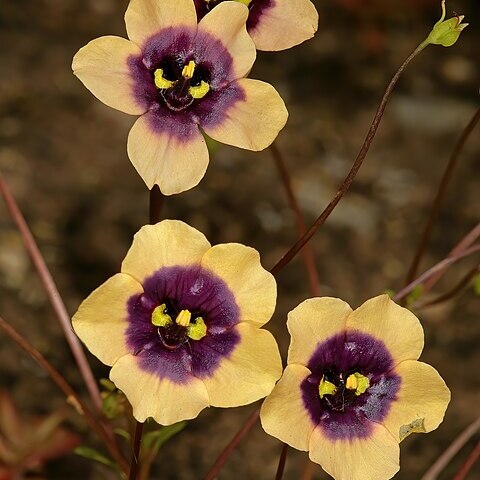Annual herb, glabrous, simple or branching from the base. Leaves many in a basal rosette, simple, lamina ovate or elliptic to obovate, 8-55 mm long, apex rounded to acute, leaf base attenuate, margins entire, repand, sinuate or irregularly cleft, lobes up to 4 mm long, triangular to widely ovate, entire, rounded to acute, petioles up to ca. 18 mm. Flowers axillary, borne from the basal leaves or from decumbent (erect in early stages of elongation) lateral stems, stems up to 400 mm long, four-sided, up to 2.0 mm on a side, flowers with a faint sweet spicy scent, nodding in early bud, bracts opposite or alternate, becoming reduced upwards; pedicels 28-50 mm long, ascending, broadened and dorsiventrally flattened especially where attached to the flower, recurving in fruit. Calyx lobes five, the uppermost lobe longest and narrowest, ca. 3.0 x 1.0-1.2 mm, lanceolate, the two adjacent lobes more or less equal, ca. 3.0-3.5 x 1.0-1.2 mm, ovate, all three upper lobes acute and recurved or strongly reflexed, the lower two lobes more or less equal, ca. 3.0-3.5 x 1.2-1.7 mm, spreading or somewhat recurved, ovate, acute, all lobes scaberulus on inner margins. Corolla bilabiate ca. 12.5-22.0 x 14.0-23.0 mm; upper lobes ca. 4.4-8.8 x 4.9-8.4 mm, widely ovate, rounded; lateral lobes ca. 5.0-9.5 x 5.6-8.5 mm, widely ovate, rounded, bases slightly oblique; lower lobe ca. 5.2-9.5 x 6.4-10.8 mm, broadly obcordate; all lobes pale orange-yellow with a purplish-red to purple base; purple portion covered with sessile or shortly stalked dark purple multicellular glandular trichomes; tube ca. 1.0-2.0 mm, distended at the base of upper corolla lobes to form two shallow sacs projecting backwards and to the side and recurved at the tips, sacs ca. 2.1-2.8 x 1.5 mm ovate in outline, very dark purple, with a dense patch of stalked multicellular trichome elaiophores at the opening on the lower side and scattered within especially where the sacs fold over near the tips; outer side of each sac opening with a falciform yellow patch that merges with a yellow horizontal stripe ca. 1 mm wide that spans the tube between the sacs, centre of tube with a ca. 0.75-1.5 mm boss bearing the stamens, mostly greenish-yellow, connected to the tube below the sinus of the upper lobes by a septum that separates the two sac openings. Stamens four, projecting upwards, anticous filaments ca. 2.5-3.0 mm long, curved, densely pubescent with long (ca. 0.5-0.7 mm) purplish trichomes on upper surface; posticous filaments ca. 2.0-2.7 mm long, nearly straight and covered with shorter (ca. 0.25 mm) purple trichomes, anthers ca. 0.7 mm long, reflexed, strongly cohering, yellow. Ovary ca. 1.5-2.0 x 1.0 mm, oblong-ovate in outline, style ca. 2.0 mm long, strongly curved upward from top of ovary; stigma capitate, surrounded by anthers, ovules ca. 40-70. Capsule ca. 6.0-9.0 x 3.5-4.2 mm, falciform-ovate in outline, more than twice as long as the calyx at maturity, seeds ca. 1.1-1.2 mm long, reticulate, embryo straight.
More
Annual herb, stems simple or branched from base, up to 400 mm high, erect to decumbent. Leaves ± ovate to obovate. Flowers axillary; pedicels 28-50 mm long, ascending, curving back in fruit. Corolla: all lobes light orange-yellow with base purplish red or purple. Sacs 2, in tube at base of upper lobes, well-developed, up to 2.8 mm long, projecting backwards and sideways and recurved at ends, ovate, dark purple; outside of each sac with a yellow patch and a yellow stripe between the 2. Flowering time May-Oct., mainly Aug.
Like D. bicolor but sacs deep violet, stamens erect and filaments with purple hairs.

